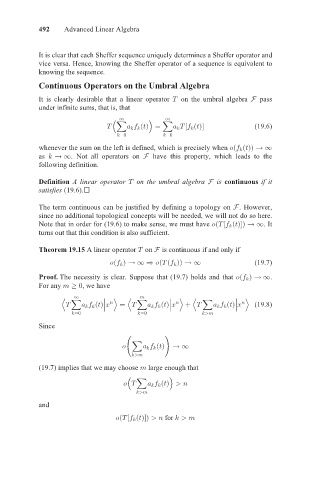Page 508 - Advanced Linear Algebra
P. 508
492 Advanced Linear Algebra
It is clear that each Sheffer sequence uniquely determines a Sheffer operator and
vice versa. Hence, knowing the Sheffer operator of a sequence is equivalent to
knowing the sequence.
Continuous Operators on the Umbral Algebra
;
It is clearly desirable that a linear operator on the umbral algebra < pass
under infinite sums, that is, that
B B
;4 ²!³ ~ 5 ;´ ²!³µ (19.6 )
~ ~
whenever the sum on the left is defined, which is precisely when ² ²!³³ ¦ B
as ¦ B . Not all operators on < have this property, which leads to the
following definition.
Definition A linear operator on the umbral algebra is continuous if it
<
;
satisfies ²19.6) .
The term continuous can be justified by defining a topology on . However,
<
since no additional topological concepts will be needed, we will not do so here.
(
)
Note that in order for 19.6 to make sense, we must have ²;´ ²!³µ³ ¦ B . It
turns out that this condition is also sufficient.
Theorem 19.15 A linear operator on is continuous if and only if
;
<
² ³ ¦ B ¬ ²;² ³³ ¦ B (19.7 )
)
(
Proof. The necessity is clear. Suppose that 19.7 holds and that ² ³ ¦ B .
For any , we have
B
L ²!³ %
L ²!³ %
L ; c M ~ ; c M b ; c M ²!³ % (19.8 )
~ ~
Since
8 ² ! ³ 9 ¦ B
(19.7 ) implies that we may choose large enough that
; ²!³
4
5
and
²;´ ²!³µ³ for 

